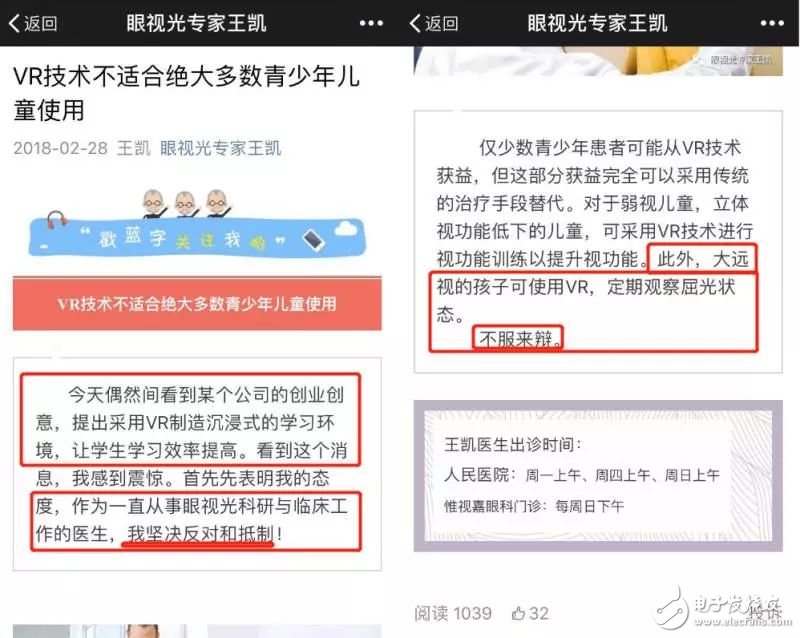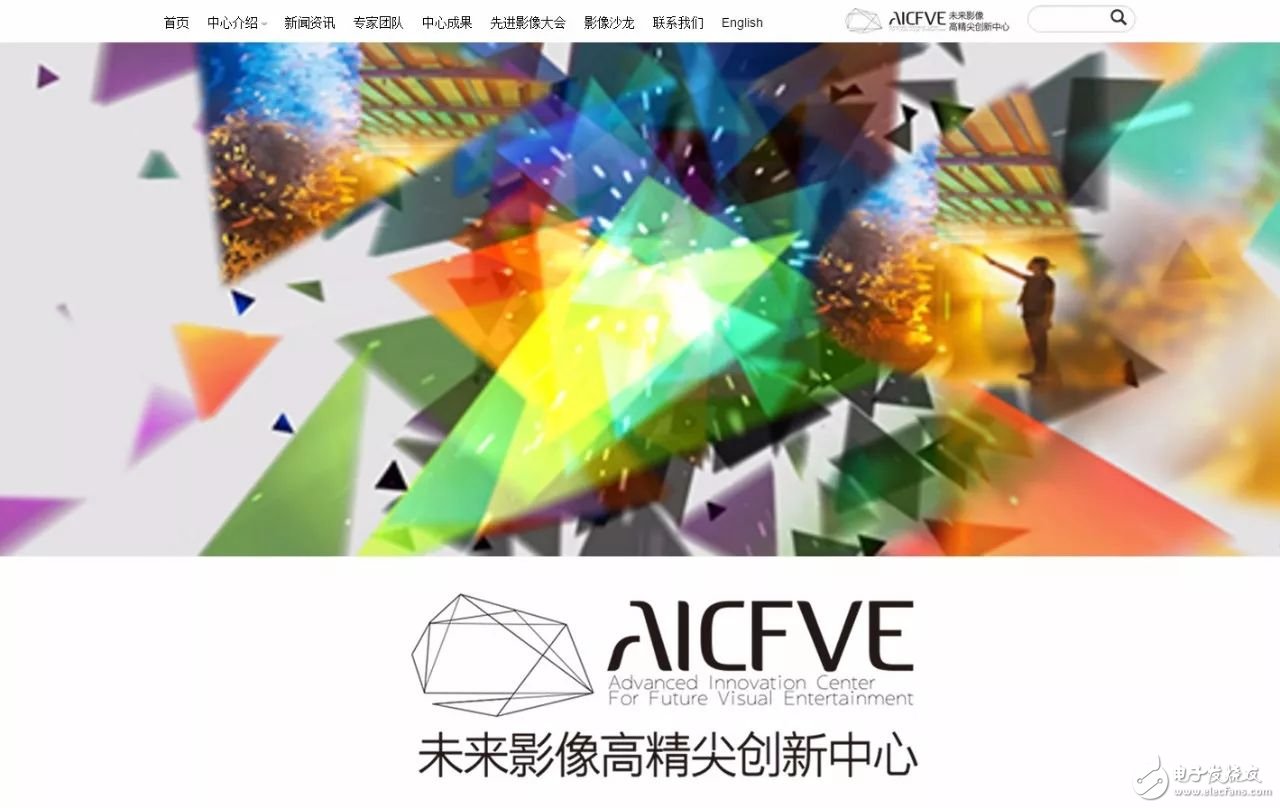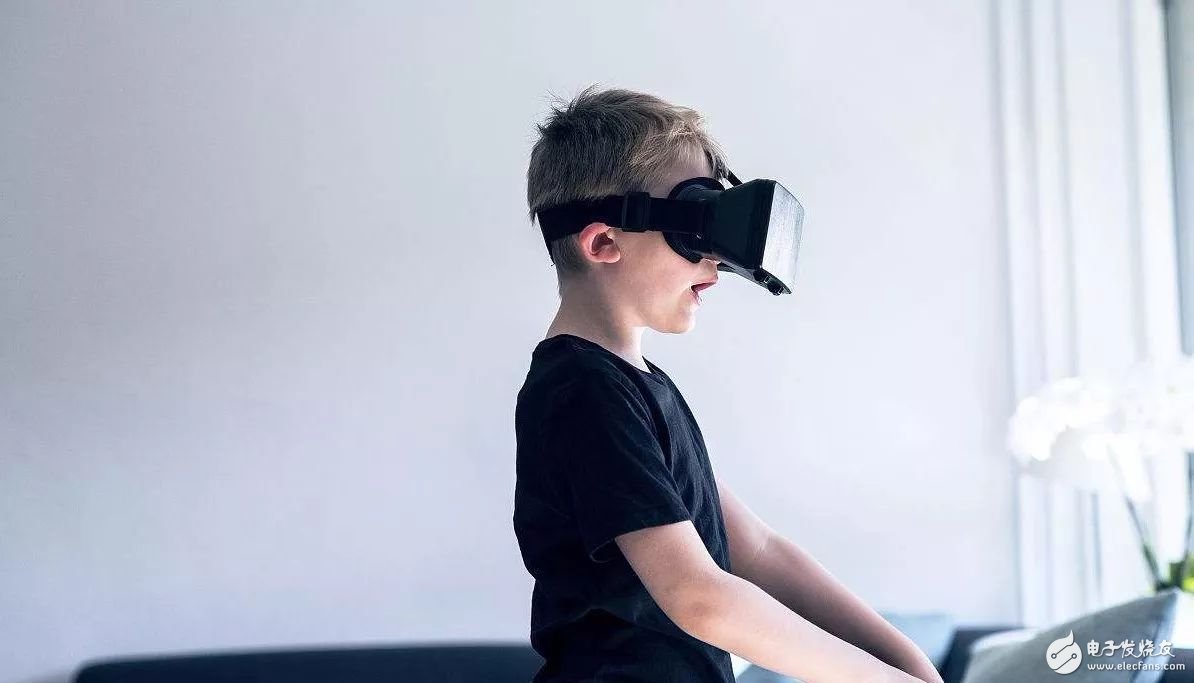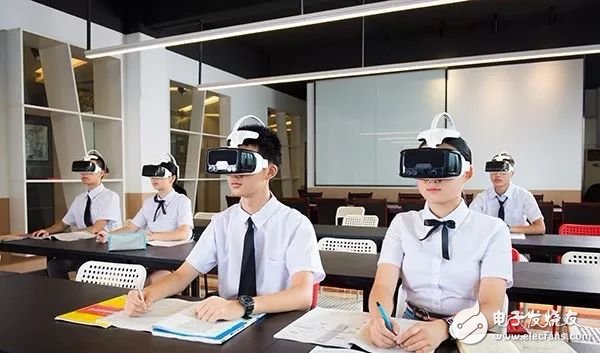The original text of the blogger: "Looking at the test report on the impact of long-term use of VR head-mounted display devices on the vision of low-age users for the long-term innovation center of the future." The purpose of this experiment is very good. Games and education are all VR. /AR's important application areas, there is currently a lack of clinical research on children using VR/AR, but there are still many areas for improvement in this experiment.
VR/AR technology, especially VR/AR display technology, is closely related to ophthalmology. In addition to the exploration of the impact of children's vision, at the ARVO conference in 2017, Professor Sun Xinghuai also reported the use of video see-through technology for amblyopia training ([^ARVO hotspots, amblyopia treatment new progress: augmented reality binocular split training] ). Future VR/AR has more applications in ophthalmology. There will also be more VR/AR companies that need medical-related research and experimentation. â€

Another article wrote that "Ophthalmology expert Wang Kai proposed to use VR to create an immersive learning environment, which will improve the efficiency of students' learning. I was shocked to see this news. First of all, I will show my attitude as a constant eyesight research. With the doctors working in clinical practice, I firmly oppose and resist!"
Today, ARinChina has the opportunity to interview Dr. Weng Dongdong from Beijing Institute of Technology. Dr. Weng has been focusing on virtual reality, augmented reality and new human-computer interaction technology. He is committed to developing a new generation of high-immersion virtual reality systems and applying them to themed entertainment and psychotherapy. Many related fields.
ARC: At present, how many R&D companies can really do the labs described in the blog? What is the status of our domestic R&D enterprise? After reading the blog, I suddenly realized that this is indeed a very serious problem, especially the scene that may involve children.
Dr. Weng: The study on the impact of long-term use of VR on users is discussed in this article, which is a study conducted by our team in 2017 with the support of Beijing Future Image Innovation Center. Regarding this research, many people in the challenge said that there is a blue cursor sponsorship, which is actually a PR project that the company gave to HTC, so it is considered a company behavior. In fact, this research lab is a pre-research project of Beijing Institute of Technology and Beijing Future Image Innovation Center. It has not received any financial support from any enterprise.

There are very few people in this field in China. Although our team has led the research, our team is mainly engaged in engineering, and is biased towards VR and AR application research. It is not particularly familiar with the ophthalmology field. At the time, there were also consulting ophthalmology. Experts, and discuss the program before the experiment, but after all, this field of experiment is too new and the degree of interdisciplinary is very deep, so the first edition actually has a lot of deficiencies. After the publication of the experimental results, many related professional friends are directly I pointed out the shortcomings. In the "-- Bowen--", I think it is actually very good. The question is very comprehensive and helpful for the follow-up study. What we thought at the time of this experiment was also to throw a brick into the jade and throw the problem out.
In the field of VR, there are several different situations in domestic enterprises. The first category is like HTC, Xiaomi, and Huawei. They are independent HMD helmets, and they are relatively strong industry leaders. They are very concerned about research in this field. However, because the market is very competitive, their research departments may not have much power to support so many research topics, especially these relatively basic research topics. Although they are actively involved in research teams in related fields and have discussed VR health issues, they are now more focused on the polishing of technology and products. As an academic institution, we will pay more attention to this basic issue.
The second type of enterprises, such as many domestic head-mounted display brand companies, actually want to pay attention to this aspect, but most of them are start-up teams. It is difficult to ask them to consider so many social responsibilities during the start-up period. The market competition is indeed Very fierce, and the industry's early revenues are not good, more is through investment support, so everyone is rushing to improve products as soon as possible. It is estimated that people who are currently paying attention to this matter are people outside the industry. People in the real industry may not be concerned about this issue.
The third category of enterprises, industry-related foundry and processing of these enterprises, as well as content-oriented enterprises, their focus on VR health issues is more "standard" as the core, for them, more important is to see How the standard is determined and then implemented according to the standard. As for the companies that are doing VR education and VR children's entertainment applications, I think they care about it or not. At present, they will unconsciously ignore this problem, or take products and market first. After all, the time of basic research will be Very long, the company can't wait.
At present, it seems that everyone can pay attention to discussing this matter is the best. We did this research at the time. In fact, there is a background. Since 2017, VR has been used in many aspects of children's education and entertainment. There are many developers who are desperate to do this industry. But in fact, including me, all people do not know how VR affects children's vision. Many things are theoretical and there is no experimental data. So I thought at the time, instead of waiting for something to happen, let’s make up the experiment. It’s better to do some experiments ahead of time and get some basic data through a process that can be controlled. At least we can have a general understanding of this problem. .
At the same time, I hope that after throwing this thing out, it can attract the attention of relevant researchers, because to be honest, this research is actually a very cross-cutting study. For example, the researchers in ophthalmology, they themselves did not pay much attention to VR at least last year, because VR is too new for them, and it is not important to study when it is needed. At the same time, for us as VR technology researchers, Ophthalmology is relatively new, so it is very crossover, and the people who actually do this are very, very few. So let's eat a crab, throw the problem out first, so that everyone can pay attention to this issue first.
ARC: Ophthalmologist Wang Kaifa's article "VR technology is not suitable for the vast majority of young people" can this article be an academic point of view? Or does the author's conclusion be strictly based on clinical trial design considerations?
Dr. Weng: Wang Kai’s article mentioned that he thinks that VR is totally unsuitable for children. I don’t totally oppose this point of view. Academics themselves need different opinions. Although they do not agree with the truth, I strongly support him. This kind of attitude that is bright and bright, and the "tit-for-tat" discussion is a particularly valuable thing in academia. Some of his arguments are mainly based on some limitations of the current display devices. There are some parts that are imperfect that we might have considered before, such as the edge field of view.
His point of view, in turn, is also a guide. This is the same as the purpose of doing this experiment. It is to tell practitioners and manufacturers what you want to do in order to make everyone feel comfortable using it. From other perspectives, these are still only discussions. Everyone is saying truth, common sense, and experience. It is still not academic. The academic level must use data to speak. The experiment we did was actually hoping to explain the problem with some data, although there are still many vulnerabilities in our data that need to be added.
Therefore, I especially hope that the relevant practitioners can also start to really study it as an academic issue, and use rigorous data to prove their point of view. Many things, through experimentation, you will find your common sense. There may be problems, such as the discovery of Poisson's bright spots.
ARC: Weng teacher, many reports now say that VR+ education, VR+ theme entertainment, etc. are not bad, then these directions are ultimately thought to be the money to make children, then the above mentioned article is the main market target for VR. Great challenge, how do you see this problem?
Dr. Weng: Although these articles have some controversy about children's use, from my personal point of view, nowadays, for children, the use of VR equipment has not reached a particularly long period of time, children use VR helmets. The time is relatively short. So there are a few suggestions. First of all, before a large amount of data comes out, the time for application design is as short as possible for children. Be cautious about children's problems. From my personal experimental data, this problem seems to be more optimistic, at least in the one-hour experiment, we saw it compared with the pad, there is no bad influence.

When it comes to the impact on the market, in fact, the people may easily ignore this effect, which is not immediately effective. After all, after wearing it, you may not immediately feel the pain in your eyes. If this is the case, I feel that no matter how noisy in our academic circles. The people should still use it, because there are manufacturers who will continue to push. But at the same time, before there is no corresponding standard, we have no way to blame the manufacturer for doing something wrong, because it is originally without standards.
So from this perspective, we also hope to promote the formation of standards as soon as possible, we are doing it ourselves, but the formation of standards is a very cumbersome and painful process. What's more, if you really want to form a standard, you must first have enough industry data to support some of your points. But to be honest, we have already done an experiment and have already been speculating. There is still not a lot of experimental data about children. Therefore, to go to the standard now can only be the brains of everyone, not very scientific. So the two are an iterative process, and there must be such a chaotic process before the real correct standard emerges. This is also the process that any product will experience.
ARC: I heard that Ge Hangbin also introduced me to some of our labs. I want to know if there are more R&D cooperation in the labs. Now the country looks like a variety of schools and enterprises to encourage cooperation, military and civilian integration.
Dr. Weng: There are many cooperations between our laboratory and the outside. We have built a cooperation platform for standard testing in Nanchang, mainly to support us to make national standards. The Nanchang government has given us considerable support, and we hope to do something for the industry in the future. contribution. One of our team's main research directions this year is about long-term immersion and long-term research in VR. We call this kind of livable VR, Livable VR. At present, it is actually more about the basic issues of technology.
In addition to research, in terms of industry. We are more concerned about the application of VR in the theme of entertainment, because we believe that a new technology is rapidly promoted. In addition to military, entertainment is the most accessible area for a new technology. We are now doing some application research on some equipment and technology of VR in large theme parks with the support of Huayi.
ARC: Regarding industry development, I think your point of view is very valuable. Your identity is to look at the industry at the forefront of the academic industry. In particular, listening to Michael tells you that you have also participated in many unofficial meetings in the industry. What is your opinion on technology and market in the next three years?
Dr. Weng: There is now a new force joining the head-mounted display, which is Microsoft. Microsoft has more and more vendors, and he defines the head-end display as a new device for interactive display. It is different from the concept of VR in our previous industry. In the past, we used VR as a brand new platform. This is actually very difficult. Whether it is a startup team or even some multinational companies, we want to completely create a new interactive platform. It is very difficult, not one or two years. What Microsoft is doing now is like an update, and he has already integrated VR into Windows 10.
I think Microsoft will have a huge impact on the next three years, but Microsoft has not yet clearly released some definitions of VR's future. My judgment is that they will pay attention to some applications of VR in the office field. This is also the most important development direction for VR in addition to entertainment in the next three years. The development of VR industry applications will be a very gradual process before the huge changes in head-mounted devices, and will slowly improve without explosive growth.
I think the most important direction in the future is to take into account the long-term use of the equipment. It also has a very big relationship with the article we discussed today. It is that VR must not be a short-term device, it will be with us. A computer screen, like a mobile phone, is a device that is used for a long time. It will take several hours and weeks to use such equipment. It is possible to make VR truly a basic thing. In order to achieve this goal, there are still a lot of hardware and software work to do. So in the past few years, I think that some giant companies may be more iterating their products to meet these needs. Once the head-mounted display meets the needs of long-term use, its quantity will be explosive. Basically, it is a device that everyone has to use.
Education is also an application direction that I am more optimistic about. The education I am talking about is not the same as the education that I am doing now. The kind of education I am talking about is more radical. It is classroom education. Of course, there is a premise that VR helmets can meet the standards for children. By that time there will be a particularly important concept of subversion, that is, we are now discussing the degree of damage to the child's eyes, but the problem we discussed a few years later is that using a VR helmet is good for the child's glasses, because it is good. The design of the head is very likely to avoid various eye diseases.
Of course, this is not to say that the current head-mounted display can directly solve these problems. I just said that the head-mounted display has the potential to solve various problems that cause eye diseases, such as the distance of viewing, the light environment and including Wang Kai. The edge field of view mentioned in the article and so on. The premise is that the performance of the head-mounted display itself meets these requirements. Designers are also required to develop targeted improvements based on these causes.
We have already started to discuss this issue, and various manufacturers have begun to pay attention. I believe that this will become a problem that everyone has solved in a few years. The problem that may be faced in the future may be that if your child wears a helmet for learning for a long time, it is likely that his child's probability of myopia is much lower, because he is in a good light environment during his study. Good viewing environment inside. There is no eye disease caused by his own posture and various conditions at home. In fact, this is a prerequisite for the large-scale use of VR in the future. We call it healthy VR.

The day when this device can be realized, this is not good, three or five years may be ten years, but it should not be too far, because many basic problems are already being solved, and of course, a new generation of technology is also needed. For example, magic leap, they claim to use the light scanning display technology. Or the next generation of better flexible oled technology is possible. The technology is still developing constantly. I believe that it will soon rise to the high line of health. Once this healthy line is passed, all the problems will be reversed. That is to say, the problem is that wearing a head is troublesome and unhealthy. So I won't use it, even if he is good. After that, after this line, no matter whether he has any advantage or not, using him is healthier than using the monitor, so the balance will be pressed.
This is my view of the technological development in the next few years. Of course, the development of the industry revolves around the development of these technologies. As long as the head-mounted display meets the health needs, it can be used by everyone, without any psychological burden, and even more tend to use it. All the industries basically can't avoid using it, so they will face a complete upgrade process of the human-machine interface. Of course, Microsoft is already doing this. It is very likely that by that time, everyone is already using Microsoft. The new VR operating system, you may have to do things, just use the new Microsoft SDK to do development, this is not easy to say.
Ethylene Propylene Rubber Tape
Ethylene Propylene Rubber Tape is a kind of Electrical Tapes.Ethylene propylene rubber in ethylene and propylene as main monomers, synthetic rubber, according to the different monomers, in molecular chain with binary ethylene-propylene rubber and EPDM, the former for ethylene and propylene copolymer, expressed in EPM, the latter for ethylene, propylene and a small amount of conjugated dienes third monomer copolymer, expressed in EPDM.
Both are collectively known as ethylene propylene rubber (EPR). Widely used in automobile parts, waterproof materials for construction, wire and cable sheath, heat-resistant hose, adhesive tape, automobile seals, lubricating oil additives and other products,as a kind of strong Waterproof Tape.
EPDM Self Fusing Electrical Tape is a kind of Ethylene Propylene Rubber Tape,it can applied in the termination of cables for insulation or applied for the bus-bar for waterproof and insulation,it is a Strong Waterproof Tape whitch could stretch up to 550% and supplied void-free and Self Fusing Insulation.
Ethylene Propylene Rubber Tape,Strong Waterproof Tape,Heat Insulation Tape,Electrical Tapes,EPDM,EPR
CAS Applied Chemistry Materials Co.,Ltd. , https://www.casac1997.com